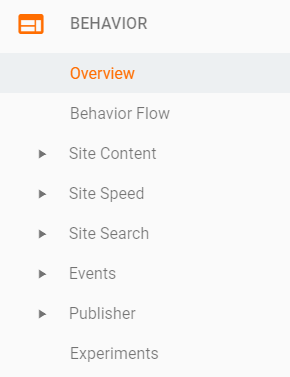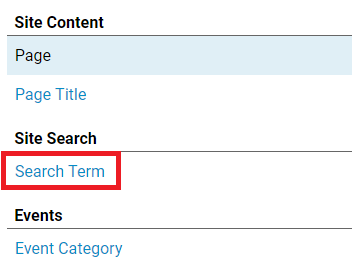Use Internal Site Search Data to Improve Your PPC Marketing
The internal search box on your website is an opportunity for you to learn about the people who use your website and what they search for. The data you obtain from your internal search analytics is an amazing resource that tells you what your visitors cannot find on your site. There is also the opportunity to build out more paid search campaigns and improve the conversion rate on your site.
Have you ever looked at your “Site Search” setting in Google Analytics before? We’ve got you covered with a handy walk-through guide at the end of this post. Go amaze your client or boss at the next quarterly meeting. I can almost guarantee you that no one on the team has looked at this report either. Now go rock out!
For example, if you sell clothing and you have hundreds of searches for “pink ball gowns,” but you don’t sell them, it might just be worth looking into selling pink ball gowns. If you receive a lot of searches for pink ball gowns, but you have a link to the pink ball gowns category right on your navigation bar, there’s a good chance that something is wrong with your site’s navigation and user experience. There are four main sources of knowledge that your internal search box can tell you:
Current Product
Looking over the search terms that people are using on your website can tell you how people view products and what they call each of your products. Are you using the same terminology as your customers? It’s important to use the same terminology as your visitors because it helps create less friction on your site.
Once you have looked over the search term report, you can see if there are gaps in your PPC campaigns and build out new campaigns to send traffic to your current products. This may even lead to you talking about the products differently on your landing pages.
New Services
Are people searching for a service you don’t offer? Does it make sense to offer this service or have a page for it and refer people to another company (maybe with a referral link). Understanding what people are coming to your site for and why, can help you find underserved areas or untapped potential with your brand. If you do offer the new service, you already have a base set of keywords you can build a campaign with.
Misspellings
Are you spelling the terminology the same way as your visitors? Misspellings by accident or because your service also caters to expats can lead to valuable keywords (e.g. behaviour vs behavior). This has been a strong growth area for a lot of our clients over the last year. Understanding the people behind each search is going to let you find out opportunities to build more relevant campaigns to market your company.
Unrelated Service
If popular site search phrases are unrelated to the nature of your business, then maybe people do not understand what your site is actually about. Making sure your site is strong on user experience and improving the conversion rate optimization (CRO) of your site will lead to more conversions on all your digital marketing campaigns.
All four sources of knowledge can help you build your keyword list for your paid search campaigns and improve your CRO, which will lead to more customers. Plus looking at the report could even feed content on your website as your company grows. Taking the time to sift through the list in your Google Analytics is an important exercise to do with any new client or even one that has been with you for years.
Turning On Site Search
Login to your Google Analytics account and click on “Admin” at the bottom left of the page. You’ll be presented with three columns: Account, Property and View. Under “View” look for “View Settings” and click on that. Scroll to the bottom of the list and turn on “Site Search Tracking”. Most sites can enter an “s” in the field when Google Analytics asks for your “query parameter”. It usually takes at least 24 hours before you start to see data. Give yourself 30 days before you start running the report below.
How To Do It
Don’t feel overwhelmed if this is the first time you’re looking at your internal site search data. Once you get the hang of it, you’ll be digging into this resource to look for the trends above. You should be looking at your internal site search every month or so. You can schedule the task along with when you refresh ad copy for your paid search campaigns.
Step 1. Login to Google Analytics and click on Behavior > Site Search > Overview on the left navigation in your account.

Step 2. Under the “Site Search” heading click on “Search Terms”, which takes you to the list of internal search terms that people are using on your site.

Step 3. Scroll down to the bottom of this page and click on the “view full report” link. Next, click on the drop down box for “Show rows” and select 500. The top 500 internal search terms is a high enough number to understand what people are actually searching for on your site. Unless you’re the size of Amazon, you shouldn’t need more than this.
Step 4. Scroll to the very top of the page and select your date range. I’d a pick a date range that coincides with your fiscal year or the start of this year, whichever is greater right now.
Step 5. Above the date range and within the grey bar area, click on “Export” and pick “CSV” from the list. This will let you download the top 500 internal search terms from your analytics.

Step 6. Once downloaded. Open the excel spreadsheet and start looking at columns B (Total Unique Searches) & F (Time after Search). Any search term that is being searched on multiple times or having people spend a lot of time on your site, is a term I’d want to place in one of the four main sources of knowledge: current product, new services, misspellings, or unrelated service.
Step 7. Once you’ve organized the list of search terms by sources of knowledge. You can start to see how the keywords can help you build your keyword list for your paid search campaigns. This keyword list may even help you improve your CRO or even give you ideas to expand the content on your site. Taking the time to sift through the list in your Google Analytics is an important exercise and one that many miss out on doing.
You’re All Set
It’s essential to note that we have barely scratched the surface of internal search analytics. However, this is a fundamental skill set you should be adding to your knowledge base within performance marketing.
 Duane Brown is the owner of Take Some Risk. He has done work for clients including ASOS, Telstra, Jack Wills, Cineplex and Grant Thornton. Living and working in 5 cities across 3 continents has allowed him to launch digital marketing campaigns around the world. Duane has been featured & interviewed in a number of publications including PSFK’s Good Brands Report, and .Net Magazine. He has spoken at MozCon, Google, Digital Summit, HeroConf and SMX London.
Duane Brown is the owner of Take Some Risk. He has done work for clients including ASOS, Telstra, Jack Wills, Cineplex and Grant Thornton. Living and working in 5 cities across 3 continents has allowed him to launch digital marketing campaigns around the world. Duane has been featured & interviewed in a number of publications including PSFK’s Good Brands Report, and .Net Magazine. He has spoken at MozCon, Google, Digital Summit, HeroConf and SMX London.
Follow Duane on Twitter @duanebrown